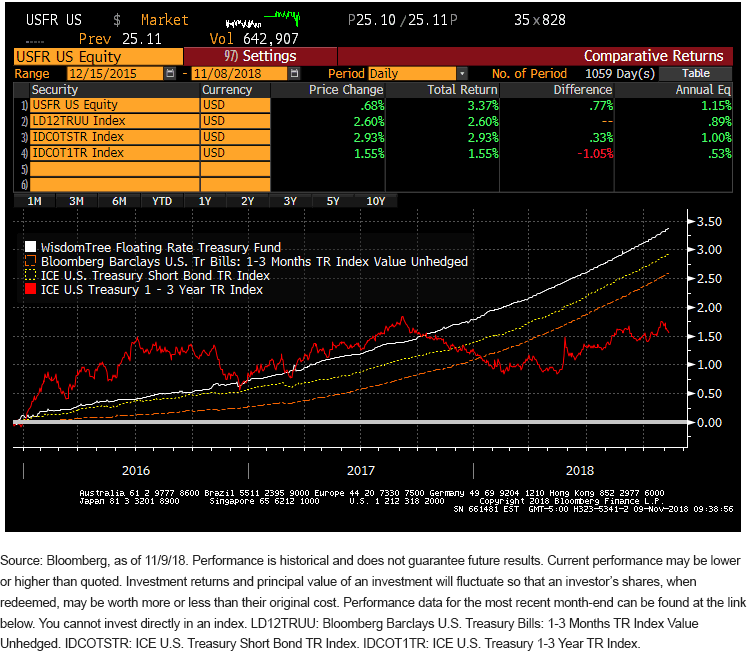Fixed Income: Money in Motion


Seven down, one more FOMC meeting to go for 2018. There were no surprises at last week’s penultimate Federal Reserve (Fed) gathering as the policy makers kept rates unchanged, but perhaps more importantly, they continued to lead money and bond markets down the path for a potential rate hike at their final convocation of the year in December. The specter of additional rate hikes next month and into 2019 has created an interesting environment in the fixed income arena, and as we get one month closer to year-end, investors appear to be putting money in motion.
As we head into the 2018 homestretch and begin preparing fixed income portfolios for what potentially lies ahead, once again, hedging rate risk remains an integral part of the equation. Investors generally utilize short duration strategies when the expectation is for higher interest rates. In other words, funds will be reallocated from intermediate to longer-dated maturities and reinvested in shorter-dated instruments. Some of the more widely used options involve U.S. Treasury securities such as t-bills or focusing on the one- to three-year Treasury note sector.

Click here for USFR standardized performance.
While the debate on where UST 10-year yields are headed will no doubt continue, one aspect that does not seem to be up for debate is that the Fed will continue with “further gradual increases” in the Fed Funds target range. In my opinion, investors should consider a Treasury floating rate strategy to complement their portfolios. The other aforementioned short duration Treasury strategies all involve fixed type of securities in one form or another, and while they can help mitigate some rate risk, they tend to underperform a floating strategy, especially in a Fed rate hike cycle.
The WisdomTree Floating Rate Treasury Fund (USFR), which seeks to track the price and yield performance of the Bloomberg U.S. Treasury Floating Rate Bond Index, offers investors a vehicle to follow this type of strategy. Let’s take a look at how this Fund has performed versus the aforementioned UST-based short duration options since the Fed implemented its first rate hike at the end of 2015. As of this writing, USFR has outperformed three widely used UST-based strategies. The largest differentials exist in the Treasury one- to three-year sector (ICE U.S. Treasury 1-3 Year TR Index) and one- to three-month t-bills (Bloomberg Barclays U.S. Treasury Bills 1-3 Month TR Index Value Unhedged), at 182 and 77 basis points (bps), respectively. Rounding out the slate, the UST floating rate vehicle also registered a higher reading, +44 bps, with the one-month to one-year part of the curve (ICE U.S. Treasury Short Bond TR Index).
Conclusion
On a final note, it looks like bond investors are going to be confronted with an environment that they have not experienced for a number of years. Indeed, given this year’s rise in interest rates and challenges in the emerging market space, a variety of fixed income investments could post losses for 2018, unless a turnaround occurs during the final six weeks or so of this year. In fact, barring any plunge in rates from here, the Bloomberg Barclays U.S. Aggregate Bond Index could register its first negative performance in a calendar year since 2013. Signs that fixed income investors are moving funds in order to potentially harvest tax losses for 2018 have already begun to emerge. Against this backdrop, USFR could also be considered a solution for these reallocated funds.
Unless otherwise stated, all data sourced is Bloomberg, as of November 9, 2018.
Important Risks Related to this Article
There are risks associated with investing, including possible loss of principal. Securities with floating rates can be less sensitive to interest rate changes than securities with fixed interest rates, but may decline in value. The issuance of floating rate notes by the U.S. Treasury is new and the amount of supply will be limited. Fixed income securities will normally decline in value as interest rates rise. The value of an investment in the Fund may change quickly and without warning in response to issuer or counterparty defaults and changes in the credit ratings of the Fund’s portfolio investments. Due to the investment strategy of this Fund, it may make higher capital gain distributions than other ETFs. Please read the Fund’s prospectus for specific details regarding the Fund’s risk profile.
Neither WisdomTree Investments, Inc., nor its affiliates, nor Foreside Fund Services, LLC, or its affiliates provide tax advice. All references to tax matters or information provided in this material are for illustrative purposes only and should not be considered tax advice and cannot be used for the purpose of avoiding tax penalties. Investors seeking tax advice should consult an independent tax advisor.


